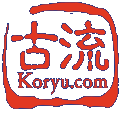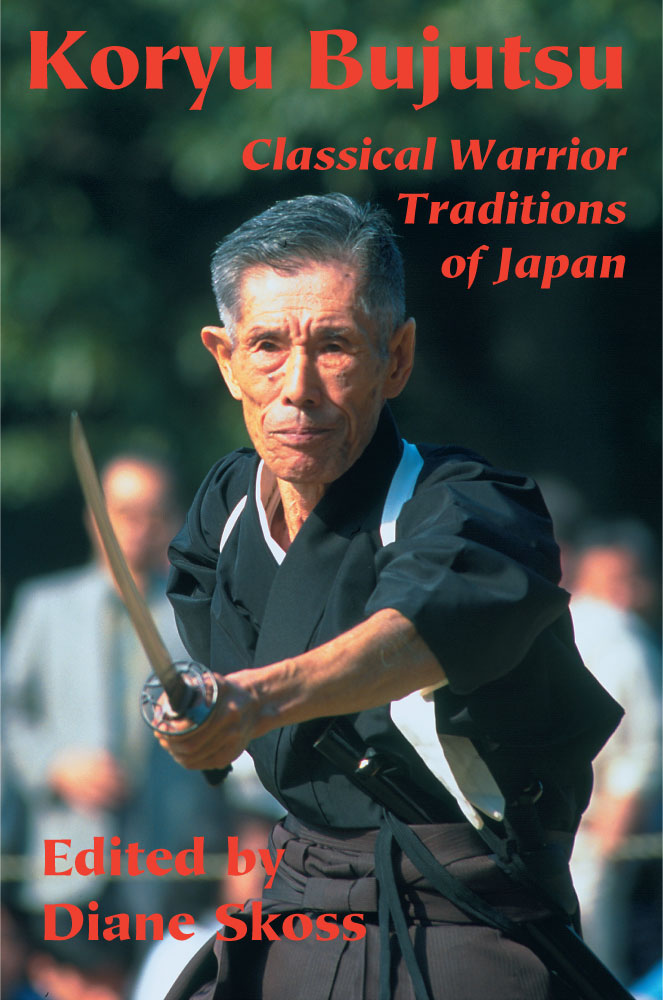[This] new venture by Diane Skoss, former editor of Aikido Journal [is] a collection of essays by various writers. After Donn Draeger’s books, there have been very few publications that I would recommend to the English-speaking martial arts public in terms of authentic martial arts culture, history, and lore, especially concerning classical budo. This new book is a rarity, something that flabbergasted me. It’s a winner; it encapsulates and brings into focus all the striving we and others like us have been doing all these years…
This is probably the best book on martial arts this year, if not for several years past and hence…
Wayne Muromoto
Editor-in-chief, Furyu #8
The classical martial traditions are dismissed by many aikidoka as purely anachronistic or so esoteric they are virtually incomprehensible. Both these views are ill-informed, which is why Koryu Bujutsu: Classical Warrior Traditions of Japan should be required reading for all aikido students.
If aikido is an evolutionary leap forward from its koryu origins, a knowledge of the latter would only help us to understand this process more clearly. Conversely, it would be a salutary lesson if we were to find this evolution was not as great as we might have imagined.
Westerners are not alone in their ignorance of koryu and I have met Japanese aikido instructors who were surprisingly so. Some dismiss koryu as not merely irrelevant but actually subversive, and insinuate that curiosity about these arts amounts to disloyalty. Such viewpoints can only be dismissed as unworthy. It is the individual’s prerogative to make up his or her own mind, after studying the facts.
Until now facts on koryu have been hard to come by, the main work on the subject in English being Donn Draeger’s books published in the 1970s.
Enter this new book published by Diane Skoss, former managing editor of Aikido journal and herself a practitioner of the classical arts and ways.
The book includes eight essays by the world’s most experienced non-Japanese practitioners of koryu, each of whom has spent decades in Japan training and researching under the headmasters of ancient traditions. As well, there are interviews with some of the leading Japanese masters.
To quote Takashi Kato (p. 149): “The goals of classical and modern budo are ultimately the same. However, the process by which these goals are pursued and achieved, in particular the emphasis of the teaching, is usually somewhat different.”
David Lynch
Managing Editor, Aikido Journal vol. 24, no. 3
I can summarize my review of this book in two words:
This is the only English language general book on koryu bujutsu that I am aware of that has come out since Donn Draeger’s day. It includes essays and interviews by Hunter Armstrong (Draeger’s successor in the International Hoplology Society), Meik Skoss, Ellis Amdur, David Hall, and Liam Keeley, as well as an overview of a number of classical bujutsu styles by the editor Diane Skoss.
Interestingly, several of the essays herein are somewhat contradictory in their analysis of the koryu, highlighting the diversity of thought among these schools. If your only exposure to the bujutsu comes from reading Draeger’s work, this book provides perspectives that are both similar to and different from his.
My favorite essay is David Hall’s, entitled “Marishiten: Buddhist Influences on Combative Behavior.” While the title seems somewhat dry, the essay is anything but. On the contrary, it is a thorough analysis in both Eastern and Western terms of the varieties of the “combat mindset.” Using the Buddhist deity Marishiten as a unifying theme, Hall draws together such diverse sources as classical Japanese swordsmen, Buddhist scholars, western psychologists, and American combat veterans to elucidate these states of mind.
Jay Swan
WWW Martial Arts Resource Page
…I wholeheartedly recommend Koryu Bujutsu: Classical Warrior Traditions of Japan to anyone interested in Japanese martial arts… Those committed to a martial discipline will find gems of insight through which to reinterpret their own experiences, as well as claims and opinions that may challenge their most cherished beliefs.
…This book is a worthwhile first effort by Koryu Books… Each contributor has something of value to say to the rest of us, and when they speak, we should listen.
Rick Polland
excerpted from a review in the
Journal of Asian Martial Arts 6:4 1997
Koryu Bujutsu takes readers into the cabalistic world of Japan’s classical bugei traditions through eight thought-provoking essays and interviews by authors with more than a century of collective experience in these arts. Editor Diane Skoss has pulled together the talents of six of the world’s most distinguished Western students of the bugei to produce a stimulating and informative volume. This is a must-read for scholars, students and afficionados of Japanese martial culture!
Karl Friday
Dept. of History
University of Georgia
Diane Skoss was kind enough to ship me a galley proof of this book for review, something I’ve never received before as editor of the JJSA, and something that propelled me to jump the book to the head of the line for review. Actually that’s a bit of a lie, I glanced through it and never put it down. I am rather attracted to books with this kind of information density.
As far as the conception and layout of Koryu Bujutsu is concerned, I can only say that the apple never falls far from the tree. Coming off a long stint as editor of the Aikido Journal, Skoss has put together a book which is more journal than novel. The book is a series of articles by a group of researchers / students, someone once called, rather affectionately, the “Draegerites”. There are articles from Hunter B. Armstrong, Meik Skoss, Diane Skoss, David A. Hall, Liam Keeley and Ellis Amdur. All students or acquaintances of Donn F. Draeger. In fact the book is dedicated to Draeger sensei and it certainly shows his influence, especially his theories on koryu, bujutsu and budo.
That said, I found it very interesting to compare Hunter Armstrong’s views on the Bujutsu vs Budo definition to those held by Kato Takashi, headmaster of the Tatsumi-ryu in the interview with Liam Keeley. The book does not shy away from presenting different viewpoints on Draeger’s theories. This is to Skoss’ credit, and shows a healthy attitude toward scholarship.
Hunter Armstrong is a strongly “orthodox” proponent of Draeger’s work, and presents his views well in the first chapter entitled “The Koryu Bujutsu Experience”. In it, Armstrong explains the difference between the Koryu Bujutsu and the more modern Budo arts, using the example of the batto (sword drawing) arts of the koryu against those arts calling themselves iaido.
Meik Skoss takes the next chapter and presents a conversation with Sawada Hanae, a Hanshi in the All Japan Naginata Federation and a teacher of Tendo-ryu naginata. This type of interview is absolutely vital information for those of us in the west who have little access to the Japanese senior instructors, and it is even more valuable when someone like Skoss is asking the right questions. Sawada sensei’s metaphor of a student and an instructor looking at a cup was especially insightful. The student looks up at the bottom of the cup, the instructor down so she can see the top and the bottom of the cup. The student can tell certain things about the cup but the instructor, through a better vantage point, can tell so much more. Several other important points follow dealing with practice today and in the past.
Diane Skoss then gives a small list of notes and photos on several koryu schools. She promises to continue this “Field Guide” in the next book, should there be one. I hope she will. The list is reminiscent of a small booklet put out by the International Hoplological Society, the next edition of which is long overdue in my humble opinion.
David Hall takes a somewhat rambling run at Marishiten and other Buddhist influences on combative behavior. I say rambling because he goes off into background explanations several times on subjects like the physiological effects of combat, Csikszentmihalyi’s “flow state”, European schools of fence, and the experience of Vietnam War Vets. This is not to say the article is hard to read, although a background in the International Hoplological Society’s distinctive jargon would help, rather that it requires a bit of concentration to follow. Pick a quiet place to sit while reading this chapter. I thought of this article while reading a review (by Joseph Svinth in the latest Journal of Asian Martial Arts,) of “On Killing: The psychological cost of learning to kill in war and society” (Lt Col Dave Grossman). It might be interesting to read that book and then David Hall’s article again to compare the two views on training the warrior for combat.
In chapter five, Meik Skoss gives a very thorough historical analysis of the Tenjin Shinyo-ryu jujutsu school. This school is of course, one of the roots of modern Judo.
The next chapter is an interview of Kato Takashi, headmaster of the Tatsumi-ryu, president of the Society for the Promotion of Classical Martial Arts, and a member of the board of examiners of the Chiba Kendo Federation. It is here that I had to smile when Kato sensei stated quite categorically (and more than once) that the goals of kenjutsu and kendo, of classical and modern budo were ultimately the same, and that the personalities and attitudes of the practitioners were also not different. This after reading the carefully constructed distinctions of Hunter Armstrong in the first chapter. Kato sensei did state that the modern budo have an emphasis on physical education and competition, while the classical traditions focus on the undiluted and authentic transmission of techniques as they were originally designed, to be effective in combat.
It was quite interesting to read this book, renewing the ideas of the Hoplological Society in my head, and then to read J.J. Donohue’s article “Ideological Elasticity: Enduring form and changing function in the Japanese martial tradition” in the Journal of Asian Martial Arts (6(2):10-25, 1997). I suspect Kato sensei would have no difficulty with Donohue’s views on the changing function (while retaining relatively static form) of martial arts in society.
The last chapter of the book, by Ellis Amdur, (Donn Draeger is his aunt… really… read the book), is worth the price of the book on its own. Titled “Koryu Meets the West”, it should be read by anyone with pretensions toward practice of the classical arts, anyone searching for the place of the Koryu in the West, and anyone who may have spent a decade or two in Japan immersed in the Koryu who is now wondering what to do with the skills and knowledge acquired. I think this lovely little article will calm more than a few “disquieted souls” and I thank Amdur for writing it.
Overall this book is a “must-have” for anyone who is serious about the study of the Japanese Martial Arts, classical or modern, bujutsu or budo. Let’s hope Koryu Books follows up with efforts just as strong as this first one.
Kim Taylor
Editor-in-chief, Journal of Japanese Sword Arts

